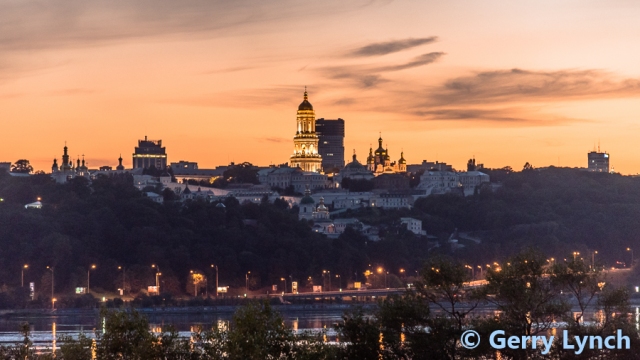Viewed here from the Paton Bridge is the enormous and ancient Pechersk Lavra monastery complex in the Ukrainian capital, Kyiv. This is the crucible in which East Slavic Orthodoxy was formed and is arguably the third most important religious community in the history Christendom behind only Monte Cassino and Mount Athos.
Kyiv Pechersk Lavra (Ukrainian: Києво-Печерська лавра; Russian: Киeво-Печерская лавра), also known as the Kiev Monastery of the Caves, was founded as a cave monastery in 1051, since which time it has usually been a preeminent centre of Orthodox Christianity in Eastern Europe. Together with the Saint Sophia Cathedral a few kilometres away, it is inscribed as a UNESCO World Heritage Site. Among others, the remains of Imperial Prime Minister Peter Stolypin, assassinated at the Opera in the city centre, lie at rest here.
While remaining a major cultural and tourist attraction, the monastery has been active again as a religious community since the 1980s, having been shut down by the Soviet authorities in 1928 and turned into a museum-park. Nowadays, there are now over 100 monks in residence.
According to the Primary Chronicle, in the early 11th century, Anthony, an Orthodox monk from Esphigmenon monastery on Mount Athos, originally from Liubech of the Principality of Chernihiv, returned to Rus’ and settled in Kiev as a missionary of monastic tradition to Kievan Rus’. He chose a cave at the Berestov Mount that overlooked the River Dnipro and a community of disciples soon grew. Prince Iziaslav I of Kiev ceded the whole mount to the Anthonite monks who founded a monastery built by architects from Constantinople.
The Great Lavra Belltower is one of the most notable features of the Kiev skyline and dominates this shot. 96.5 metres in height, it was built in 1731–45, and was designed in the neo-classical style by the architect Johann Gottfried Schädel.
Immediately to its right are the domes of the Dormition Cathedral. Originally dating back to the 11th Century, this was destroyed in the First Battle of Kyiv (1941) with Soviet and Nazi German forces each accusing the other of doing so. The cathedral was finally restored after Ukrainian independence and the new Dormition Cathedral was consecrated in 2000.
Currently, the jurisdiction over the site is divided between the state museum, National Kyiv-Pechersk Historic-Cultural Preserve, and the Ukrainian Orthodox Church-Moscow Patriarchate as the site of the chief monastery of that Church and the residence of its leader, Onufrius, Metropolitan of Kiev and All Ukraine.
This description incorporates text from the English Wikipedia.






